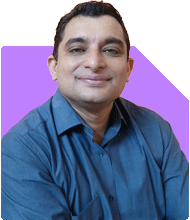Sunil Lala | Answer |Ask -Follow
Financial Planner - Answered on Mar 31, 2023

Dear Sunil Lala Sir, I am already 47 Years old with Housing Loan about 1 Crore and wanted to have some retirement plan in 10 years where i can get min 15K to 20K per month , please suggest any guaranteed income and ready to invest 1 Lakh per anum for 5 to 7 years.
You may like to see similar questions and answers below
Ramalingam Kalirajan |8292 Answers |Ask -Follow
Mutual Funds, Financial Planning Expert - Answered on Apr 10, 2024
Ramalingam Kalirajan |8292 Answers |Ask -Follow
Mutual Funds, Financial Planning Expert - Answered on Apr 30, 2024
Ramalingam Kalirajan |8292 Answers |Ask -Follow
Mutual Funds, Financial Planning Expert - Answered on Aug 21, 2024
Ramalingam Kalirajan |8292 Answers |Ask -Follow
Mutual Funds, Financial Planning Expert - Answered on Feb 05, 2025
Dr Dipankar Dutta |1172 Answers |Ask -Follow
Tech Careers and Skill Development Expert - Answered on Apr 26, 2025
Dr Dipankar Dutta |1172 Answers |Ask -Follow
Tech Careers and Skill Development Expert - Answered on Apr 26, 2025
Radheshyam Zanwar |1572 Answers |Ask -Follow
MHT-CET, IIT-JEE, NEET-UG Expert - Answered on Apr 26, 2025
Dr Dipankar Dutta |1172 Answers |Ask -Follow
Tech Careers and Skill Development Expert - Answered on Apr 26, 2025
Dr Shakeeb Ahmed Khan |154 Answers |Ask -Follow
Physiotherapist - Answered on Apr 26, 2025
Mayank Chandel |2239 Answers |Ask -Follow
IIT-JEE, NEET-UG, SAT, CLAT, CA, CS Exam Expert - Answered on Apr 26, 2025
Mayank Chandel |2239 Answers |Ask -Follow
IIT-JEE, NEET-UG, SAT, CLAT, CA, CS Exam Expert - Answered on Apr 26, 2025
Prof Suvasish Mukhopadhyay |593 Answers |Ask -Follow
Career Counsellor - Answered on Apr 26, 2025
Prof Suvasish Mukhopadhyay |593 Answers |Ask -Follow
Career Counsellor - Answered on Apr 26, 2025
Prof Suvasish Mukhopadhyay |593 Answers |Ask -Follow
Career Counsellor - Answered on Apr 26, 2025
























